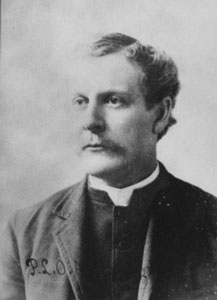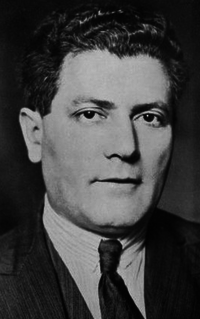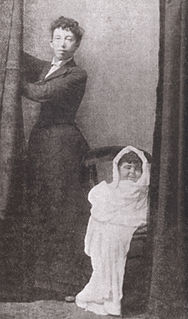

Pierre Louis Ormond Augustus Keeler (1855-1942), best known as Pierre L. O. A. Keeler, was an American spiritualist medium. [1]


Pierre Louis Ormond Augustus Keeler (1855-1942), best known as Pierre L. O. A. Keeler, was an American spiritualist medium. [1]
Keeler was best known for his materialization, pellet-reading, and slate-writing mediumship. He was investigated in 1885 by the Seybert Commission, which suspected his phenomena was fraudulent. [1] [2]
The magician Henry R. Evans sat with Keeler in April 1895 and suspected that he had written the 'spirit' messages on the slates himself. According to Evans "I was sure he was writing under the table; I heard the faint rubbing of a soft bit of pencil upon the surface of a slate... several times I saw him put his fingers into his vest pockets, and he appeared to bring up small particles of something, which I believe were bits of the white and coloured crayons used in writing the messages." [3]
Psychical researcher Hereward Carrington, who visited Keeler at Lily Dale in 1907, caught him cheating by substituting slates and commented "for not only did I see Keeler make the exchange, but the slates I received at the conclusion of the seance were different from those I examined... Keeler is a clever trickster, and the degree of perfection he has attained certainly seems to indicate that he must have been in the habit of practising these tricks continuously for a number of years." [4]
He was exposed as a fraud by the magician Harry Houdini, who had his niece Julia Sawyer attend a séance. During the séance she invented a non-existent sister and spoke of deceased relatives who were alive. Keeler, unaware of the trap, claimed to 'channel' the spirits of the sister and relatives. [5] He was also exposed by the psychical researcher Walter Franklin Prince, who made comparisons of the 'spirit' messages to the handwriting of the deceased to discover they were inaccurate. [6]
Keeler was once arrested in New York City for giving fake materialization séances. He was chased by the police and escaped out of a window but was eventually arrested. [7]
Keeler was alleged to have channelled the spirit of Abraham Lincoln by producing a signed message on a slate. The slate is located at the Lily Dale Museum. Skeptical investigator Joe Nickell, who made a detailed examination of the slate, concluded it had no resemblance to Lincoln's handwriting and described the message as "bogus". [8]
Keeler's brother William was a medium and spirit photographer. He was also exposed as a fraud by Walter Franklin Prince. [9] [10]

Spiritualism is a religious movement based on the belief that the spirits of the dead exist and have both the ability and the inclination to communicate with the living. The afterlife, or the "spirit world", is seen by spiritualists, not as a static place, but as one in which spirits continue to evolve. These two beliefs—that contact with spirits is possible, and that spirits are more advanced than humans—lead spiritualists to a third belief: that spirits are capable of providing useful knowledge about moral and ethical issues, as well as about the nature of God. Some spiritualists will speak of a concept which they refer to as "spirit guides"—specific spirits, often contacted, who are relied upon for spiritual guidance. Spiritism, a branch of spiritualism developed by Allan Kardec and today practiced mostly in Continental Europe and Latin America, especially in Brazil, emphasizes reincarnation.

A séance or seance is an attempt to communicate with spirits. The word séance comes from the French word for "session", from the Old French seoir, "to sit". In French, the word's meaning is quite general: one may, for example, speak of "une séance de cinéma". In English, however, the word came to be used specifically for a meeting of people who are gathered to receive messages from ghosts or to listen to a spirit medium discourse with or relay messages from spirits. In modern English usage, participants need not be seated while engaged in a séance.
The Eddy Brothers were William and Horatio Eddy, two American mediums best known in the 1870s, who claimed psychic powers.

Mediumship is the practice of purportedly mediating communication between spirits of the dead and living human beings. Practitioners are known as "mediums" or "spirit mediums". There are different types of mediumship or spirit channelling, including seánce tables, trance, and ouija.

Eusapia Palladino was an Italian Spiritualist physical medium. She claimed extraordinary powers such as the ability to levitate tables, communicate with the dead through her spirit guide John King, and to produce other supernatural phenomena.

Mina "Margery" Crandon was a psychical medium who claimed that she channeled her dead brother, Walter Stinson. Investigators who studied Crandon concluded that she had no genuine paranormal ability, and others detected her in outright deception. She became known as her alleged paranormal skills were touted by Sherlock Holmes author Sir Arthur Conan Doyle and were disproved by magician Harry Houdini. Crandon was investigated by members of the American Society for Psychical Research and employees of the Scientific American.

Henry Slade (1835–1905) was a famous fraudulent medium who lived and practiced in both Europe and North America.

Ectoplasm is a term used in spiritualism to denote a substance or spiritual energy "exteriorized" by physical mediums. It was coined in 1894 by psychical researcher Charles Richet. Although the term is widespread in popular culture, the physical existence of ectoplasm is not accepted by science and many purported examples were exposed as hoaxes fashioned from cheesecloth, gauze or other natural substances.
The American Society for Psychical Research (ASPR) is the oldest psychical research organization in the United States dedicated to parapsychology. It maintains offices and a library, in New York City, which are open to both members and the general public. The society has an open membership, anyone with an interest in psychical research is invited to join. It maintains a website; and publishes the quarterly Journal of the American Society for Psychical Research.

William Stainton Moses (1839–1892) was an English cleric and spiritualist medium.

Nandor Fodor was a British and American parapsychologist, psychoanalyst, author and journalist of Hungarian origin.

Leonora Piper was a famous American trance medium in the area of Spiritualism. Piper was the subject of intense interest and investigation by American and British psychic research associations during the early 20th century, most notably William James and the Society for Psychical Research.

Franek Kluski, real name Teofil Modrzejewski (1873-1943), was a Polish medium.

Walter Franklin Prince was an American parapsychologist and founder of the Boston Society for Psychical Research in Boston.

Hereward Carrington was a well-known British-born American investigator of psychic phenomena and author. His subjects included several of the most high-profile cases of apparent psychic ability of his times, and he wrote over 100 books on subjects including the paranormal and psychical research, conjuring and stage magic, and alternative medicine. Carrington promoted fruitarianism and held pseudoscientific views about dieting.

James Hervey Hyslop, Ph.D., LL.D, was an American psychical researcher, psychologist, and professor of ethics and logic at Columbia University. He was one of the first American psychologists to connect psychology with psychic phenomena. In 1906 he helped reorganize the American Society for Psychical Research (ASPR) in New York City and served as the secretary-treasurer for the organization until his death.

William Eglinton (1857–1933), also known as William Eglington was a British spiritualist medium who was exposed as a fraud.

Richard Hodgson (1855–1905) was an Australian-born psychical researcher.

Kathleen Goligher was an Irish spiritualist medium. Goligher was endorsed by engineer William Jackson Crawford who wrote three books about her mediumship but was exposed as a fraud by physicist Edmund Edward Fournier d'Albe in 1921.

Annie Fairlamb Mellon (1850–1938) also known as Mrs. J. B. Mellon was a British materialization medium.